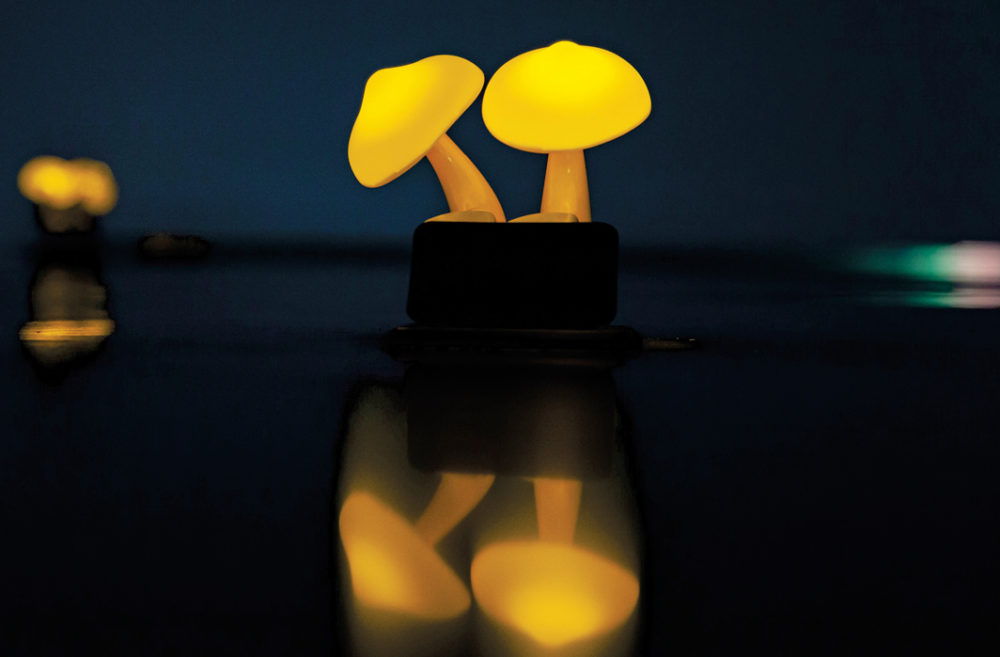
- Source: ARTFORUM
- Author: Yang Yang
- Date: March 2, 2020
- Format: Digital
“More, More, More”
TANK SHANGHAI 上海油罐艺术中心

Ghislaine Leung, Shrooms (detail), 2016, night-lights, plug adapters, dimensions variable. From “More, More, More.” Photo: Xianhe D. Kong.
The first stage of the two-part exhibition “More, More, More” opened in July as Shanghai’s monthslong “plum rain” season drew to a close. The steamy climate and general mugginess provided a fitting context for the thirty-seven works on view, especially for the moss creeping along a staircase wall in Jenna Sutela’s Bo Bo Bo, 2020, or the mushroom lamps thrusting up from the floor outlets in Ghislaine Leung’s Shrooms, 2016—both works acute reminders of the surrounding environment nurturing and sustaining our various bodily forms, human and nonhuman. These pieces emerged, in part, from the a priori conditions of the exhibition: The moss was inspired by and named after the show’s own title (bo means “more” in a fictitious Martian language of a medium’s invention), and the configuration of the mushroom lamps was contingent upon the availability of outlets throughout the exhibition as it progressed from one “phrasing,” or chapter, to the next. A similar synergetic environment and collective creativity came across in the line drawings of Chelsea Culprit. Human torsos and tree trunks, fingers and twigs, inextricably intertwine and conflate in one writhing heap.
Aside from giving prominence to collaborative authorship, the exhibition drew attention to the materiality of language. Speaking of the exhibition title (the name of a 1970s disco hit), the curators remarked on how the repetition of a word tends to obviate its meaning while at the same time foregrounding linguistic qualities such as cadence and texture. How, then, does a triplet like “More, More, More” negotiate its manifestation in the layered interfaces of communicative attempts? The exhibition tackled this question with a series of dance and performance works infused with rhythms and beats. The contested dialectic of medium physicality was invoked in Cecilia Bengolea’s video projection Lightning Dance, 2018. A group of young Jamaican dancers deliver an intense impromptu performance despite a heavy rainfall and occasional thunder and lightning. The dance movements both summon and mediate a larger ecosystem.
Four months later, in November, amid dozens of exhibitions opening and vying for attention during Shanghai Art Week, “More, More, More” blossomed into its second phase, with the addition of two dozen works and the removal of some others. As in its predecessor, narratives of cross-ecosystem bonding and affiliation proliferated, equal parts tactile and fanciful, often accomplished via the individualist channel of enhanced sensation. Against the overarching register of sensuality, the show gave a somewhat unexpected nod to the restrained aesthetics of modernist art and design in a manner difficult to reductively characterize as problematizing, decanonizing, or reclaiming. Take the work of Nicole Wermers, who coated an entire wall with white paint mixed with ground oats. The resulting grainy texture evoked Raufasertapete, or ingrain wallpaper, once a staple in many German households, especially after its application to Berlin’s Neue Nationalgalerie by Mies van der Rohe. Intervening similarly in space with Columns on Pajamas, 2020, Ad Minoliti wrapped some of Tank’s diagonal columns with textiles printed in patterns of kitschy cat figures, irregular geometric shapes, and anonymous manga characters outlined as in a coloring book. Covering up and disguising Tank’s architecture (the space was formerly an aircraft fuel–storage station), the work beckoned viewers with anthropomorphic affection and subcultural fandom while posing new questions about modernism’s legacy.

